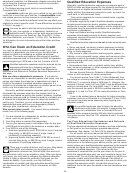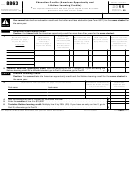Instructions For Form 8863 - Education Credits (American Opportunity, Hope, And Lifetime Learning Credits) - 2009
ADVERTISEMENT
2 0 09
Department of the Treasury
Internal Revenue Service
Instructions for Form 8863
Education Credits (American Opportunity, Hope, and Lifetime Learning Credits)
Midwestern disaster area may elect to continue to claim the
Section references are to the Internal Revenue Code unless
Hope credit for all students based on the previous Hope credit
otherwise noted.
rules.
General Instructions
Income limits increased for Hope and lifetime learning
credits. The amount of your tentative Hope and lifetime
learning credits for 2009 is gradually reduced (phased out) if
What’s New
your MAGI is between $50,000 and $60,000 ($100,000 and
American opportunity credit. This new education tax credit
$120,000 if you file a joint return). You cannot claim these
(a modification of the Hope credit) is available for 2009 and
credits if your MAGI is $60,000 or more ($120,000 or more if
2010. The maximum credit per student is $2,500 (100% of the
you file a joint return).
first $2,000 and 25% of the next $2,000 of qualified education
Purpose of Form
expenses). The credit is available for the first 4 years of
postsecondary education and 40% of the credit (up to $1,000)
Use Form 8863 to figure and claim your education credits,
is refundable for many taxpayers. The amount of your credit for
which are based on qualified education expenses paid to an
2009 is gradually reduced (phased out) if your modified
eligible postsecondary educational institution. For 2009, there
adjusted gross income (MAGI) is between $80,000 and $90,000
are three education credits.
•
($160,000 and $180,000 if you file a joint return). You cannot
The American opportunity credit, part of which may be
claim this credit if your MAGI is $90,000 or more ($180,000 or
refundable. Complete Parts I, IV, and V.
•
more if you file a joint return). Taxpayers with at least one
The Hope credit, which is nonrefundable and only for
student attending an eligible educational institution in a
taxpayers with at least one student attending an eligible
Table 1. Comparison of Education Credits
Caution. If you have more than one student eligible for the American opportunity credit or the Hope credit, you must claim the same
credit for all eligible students. You cannot claim both the American opportunity credit and the Hope credit on the same tax return.
However, you can claim both the American opportunity credit and the lifetime learning credit, or the Hope credit and the lifetime learning
credit on the same return — but not for the same student.
American Opportunity Credit – NEW
Hope Credit*
Lifetime Learning Credit
Maximum credit
Up to $2,500 credit per eligible student Up to $1,800 ($3,600 if a student in a
Up to $2,000 ($4,000 if a student in a
Midwestern disaster area) credit per
Midwestern disaster area) credit per
eligible student
return
Limit on modified
$180,000 if married filling jointly;
$120,000 if married filling jointly;
adjusted gross
$90,000 if single, head of household, or
$60,000 if single, head of household, or qualifying widow(er)
income (MAGI)
qualifying widow(er)
Refundable or
40% of credit may be refundable; the
Nonrefundable — credit limited to the amount of tax you must pay on your taxable
nonrefundable
rest is nonrefundable
income
Number of years
Available ONLY for the first 4 years of
Available ONLY for the first 2 years of
Available for all years of postsecondary
of postsecondary
postsecondary education
postsecondary education
education and for courses to acquire or
education
improve job skills
Number of tax
Available ONLY for 4 tax years per
Available ONLY for 2 tax years per
Available for an unlimited number of
years credit
eligible student (including any year(s)
eligible student
years
available
Hope credit was claimed)
Type of degree
Student must be pursuing an undergraduate degree or other recognized education Student does not need to be pursuing a
required
credential
degree or other recognized education
credential
Number of
Student must be enrolled at least half time for at least one academic period
Available for one or more courses
courses
beginning during the year
Felony drug
No felony drug convictions on student’s records
Felony drug convictions are permitted
conviction
Qualified
Tuition and required enrollment fees.
Tuition and required enrollment fees (including amounts required to be paid to the
expenses
Course-related books, supplies, and
institution for course-related books, supplies, and equipment). Additional expenses
equipment do not need to be purchased allowed for students in Midwestern disaster areas.
from the institution in order to qualify.
Payments for
Payments made in 2009 for academic periods beginning in 2009 and in the first 3 months of 2010
academic periods
* You can claim the Hope credit only if at least one eligible student is attending an eligible educational institution in a Midwestern disaster area (see Table 2 on
page 6 for a list of qualifying disaster areas).
Cat. No. 53002G
ADVERTISEMENT
0 votes
Related Articles
Related forms
Related Categories
Parent category: Financial
 1
1 2
2 3
3 4
4 5
5 6
6








